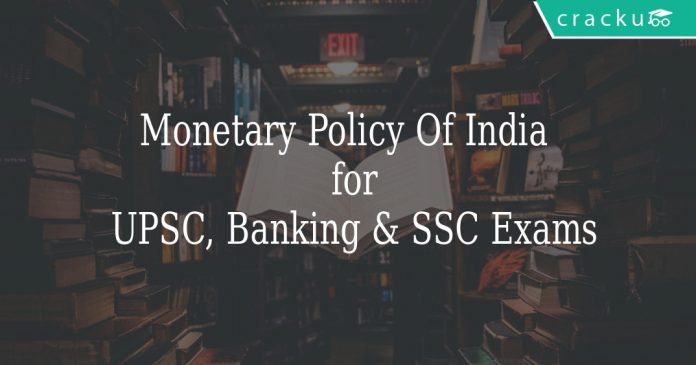Learn about Monetary policy in India which is useful for competitive exams. Download Monetary policy in India 2018 PDF very useful for UPSC, BANKING & SSC EXAMS PDF.
MONETARY POLICY Of India PDF:
Download Monetary policy of India PDF
75 IBPS Clerk mocks for just Rs. 199 (latest pattern)
Download Daily & Monthly Current affairs quiz PDF
Download all General Knowledge Questions & Answers PDF
Download Current Affairs Questions & Answers PDF
Download General Science Notes And Q&A PDF
Monetary policy:
The policy that regulates the demand & supply of the money in the economy is the monetary policy. The monetary policy is announced by the Central bank in the country i.e, RBI. RBI uses many instruments to put in place the required kind of monetary policy – CRR, SLR, Bank rate, Repo & Reverse Repo rates, MSF rate, Open Market Operations , etc.Earlier monetary policy is announced twice in slack season (April- sept) & busy season ( oct – mar ).Presently RBI releases bimonthly monetary policy statement i.e, every 2 months from April,2014 on the recommendation of Urjit patel committee.
Monetary Policy is crafted with focus on
1.Economic growth
2.Price stability
3.Exchange rate stability
4.Employment
5.Balancing savings & investments
Types of monetary policy:
Monetary policy is of 2 types: 1. Expansionary policy
2.Contractionary policy
Expansionary monetary policy corresponds to decrease in the interest rates & increase in the money supply in the economy and it is formulated to combat the unemployment as well as in times of recession to stimulate the economy. Contractionary monetary policy corresponds to an increase in the interest rates & decrease in the money supply and it is formulated to combat inflation in the economy.
Download App to Access Directly on Mobile
Types of instruments of the monetary policy:
RBI uses two types of instruments for the implementation of the monetary policy.They are
1.Quantitative instruments
2.Qualitative instruments
Quantitative instruments Of Monetary Policy:
1.Bank rate:
It is an interest rate at which RBI lends its long-term loans to the Government of India, state governments, financial institutions,NBFCs etc. It has direct impact on the long term lending activities of the financial system.
Bank rate – 6.75%
2.Cash Reserve Ratio:
It is the ratio of the total deposits of a bank in India i.e, kept with RBI in the form of cash. It earns no interest.It is governed by Section 42 of RBI Act, 1934. RBI Act, 1934 & Banking Regulation Act, 1949 are ammended in 2007 to remove floor & cap on CRR.
Cash Reserve Ratio – 4%
Download General Knowledge Questions PDF
3.Incremental Cash Reserve Ratio:
During demonetisation, to channelize the hefty deposits RBI came up with temporary measure of Incremental CRR from september 2016 to november 2016.
4.Statutory Liquidity Ratio:
It is a portion of time & demand liabilities to be maintained by the bank in the form of government securities, public sector bonds, current account balances with other banks, gold. It is governed by Section 24 of Banking Regulation Act, 1949. The cap on the SLR is 40%.
Statutory Liquidity Ratio – 19.5%
Difference between SLR & CRR:
SLR is a long term tool which earns interest & deals with securities while CRR is a short & medium term tool which doesn’t earn interest & deals with cash.
5.Repo rate :
The rate of interest RBI charges on the short term borrowings is the repo rate .It is a repurchase obligation rate where RBI & the other party agree to sell & repurchase same security at a future date with a predetermined price. This rate has direct impact on the interest rate banks charge on the loans.
Repo rate – 6.5%
6.Reverse repo rate:
It is the reverse of the repo rate . It is the rate of the interest the RBI pays to its clients who offer short term loan to it.RBI sells the government securities to the clients with a promise to repurchase at a higher price after a certain period.
Reverse repo rate – 6.25%
7.Marginal standing facility :
Under this scheme, the banks can borrow overnight upto 1% of the net demand & time liabilities from the RBI at a higher interest rate. MSF rate is a penal rate because the banks borrowing under this scheme will have a breach of SLR.
Marginal standing facility – 6.75%
8.Liquidity Adjustment facility:
It is used to cover day to day mismatches in liquidity or short term credit shortages of banks during the periods of economic instability using repo rate and reverse repo rate.It is available to all banks & to certain non-banking institutions.
9.Open market operations:
It is a scheme where there is a outright purchase & sale of government securities in open market by the RBI in order to influence the money supply in the country.When there is excessive supply of money in the economy, RBI sells govt securities to absorb excessive supply & similarly RBI buys govt securities to infuse money supply into the economy.
10.Marginal cost of funds based lending rate:
The marginal cost of funds based lending rate (MCLR) refers to the minimum interest rate of a bank below which the bank cannot lend, except in some cases allowed by the RBI. It is an internal benchmark or reference rate for the bank.The MCLR was introduced by the Reserve Bank of India with effect from April 1, 2016. MCLR replaced the base rate system introduced in July 2010.It is used by the RBI for monetary policy transmission.
Qualitative instruments of monetary policy:
1.Margin requirement:
It involves tools like minimum compulsory lending to a particular sector, compulsory lending to a sector at a lower interest rate or differential rates of interest for different sector loans etc.Ex: Priority sector lending which stipulates the lending of 40% of the total loans to the priority sectors in the economy.
2.Rationing of credit:
It includes the tools such as fixing the maximum limit to the loans & advances to a particular sector. Margin requirements, rationing of credit are the selective credit controls.
3.Moral suasion:
It is a persuasion measure used by the RBI to influence banks to adhere to the policy.





